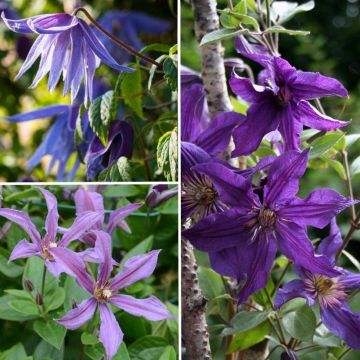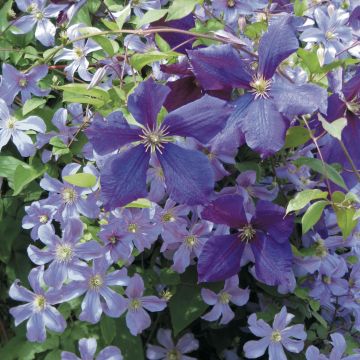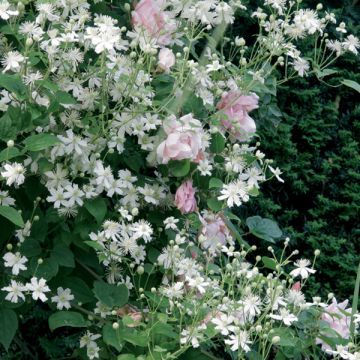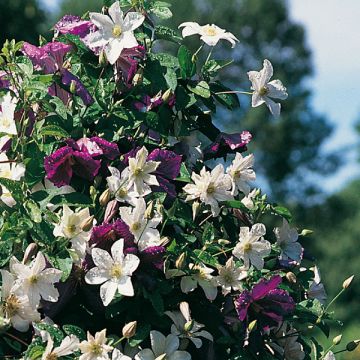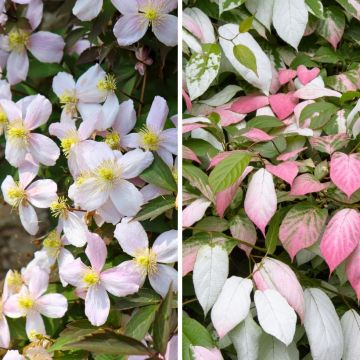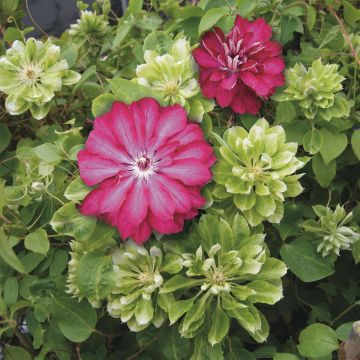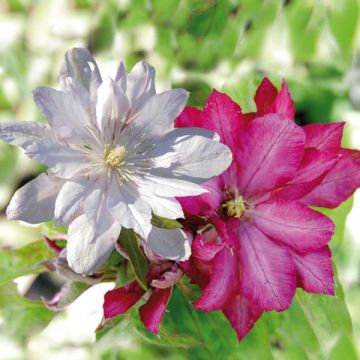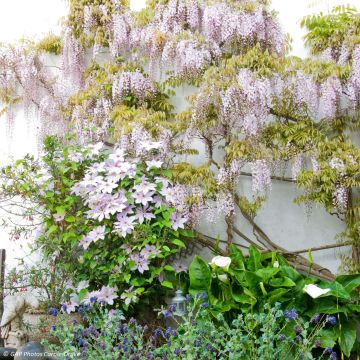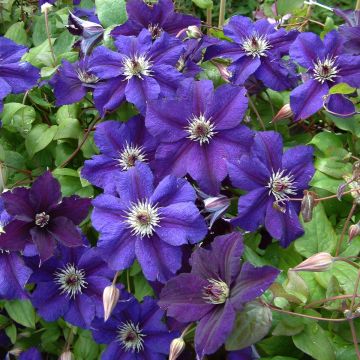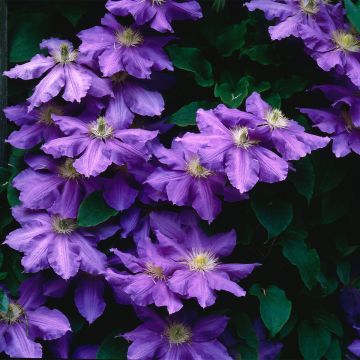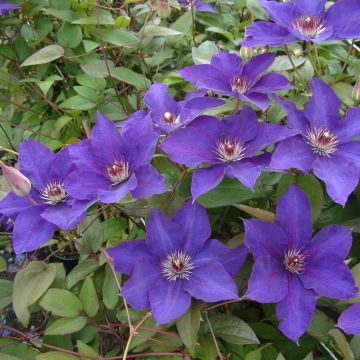

A Natural Duo - Clematis fargesii and Golden Hops
A Natural Duo - Clematis fargesii and Golden Hops
Very healthy clematis Hops in dormant period Hoping for a good recovery in spring Thanks to the person on the phone who understood my little delivery concerns Very nice catalogue
Pascale F., 05/10/2018
Special offer!
Receive a €20 voucher for any order over €90 (excluding delivery costs, credit notes, and plastic-free options)!
1- Add your favorite plants to your cart.
2- Once you have reached €90, confirm your order (you can even choose the delivery date!).
3- As soon as your order is shipped, you will receive an email containing your voucher code, valid for 3 months (90 days).
Your voucher is unique and can only be used once, for any order with a minimum value of €20, excluding delivery costs.
Can be combined with other current offers, non-divisible and non-refundable.
This plant carries a 6 months recovery warranty
More information
We guarantee the quality of our plants for a full growing cycle, and will replace at our expense any plant that fails to recover under normal climatic and planting conditions.
Would this plant suit my garden?
Set up your Plantfit profile →
Description
Here is a pair of natural climbing plants, to be planted freely in a hedge, on a fence, an old tree, a cabin or any slightly unsightly structure that it will quickly cover: the thousand white stars of the vigorous Clematis fargesii blend all summer with the beautiful golden leaves of the Golden Hops. The spectacle continues into late summer and autumn, when the feathery and silver fruits of the beautiful Clematis fargesii accompany the fragrant cones of its companion. Install these two climbers in the sun or partial shade, in the same hole, in any good, rather moist garden soil.
This natural duo is composed of a Clematis fargesii Summer Snow and a Humulus lupulus Aureus plant.
Clematis fargesii (synonym C. potaninii var. potaninii , C. fargesii souliei ), from the Ranunculaceae family, is a vigorous deciduous woody climbing plant native to China. Humulus lupulus Aureus, on the other hand, belongs to the Cannabaceae family and is native to Europe, temperate Asia, and northern Africa. Both climbing plants can easily reach a height of 5m (16ft), with a minimum spread of 2m (7ft). The Clematis, whose stems are woody, loses its foliage in winter. The golden hop regrows its entire vegetation each year from its powerful rhizomatous stump. Both are perfectly resistant to cold and show rapid and vigorous growth in deep and moist soil.
The Clematis fargesii blooms generously from July to October. Its star-shaped flowers with 6 white petals and long cream stamens, 4 to 5cm (2in) wide, are gathered in small clusters. The flowers, slightly fragrant, is followed by decorative silvery grey feathery fruits that persist until winter. The deciduous leaves are divided into small, glabrous, somewhat dark green leaflets. This clematis attaches itself to the support or host plant through petioles transformed into tendrils. While it possesses great vigour, it never suffocates the plants it climbs under its vegetation.
Humulus lupulus Aureus, a perennial climber with rapid growth, has slightly less development than the typical species, and distinguishes itself with its magnificent leaves that change from butter yellow to yellow-green during the season. Its stems cling to their support thanks to small hook-shaped hairs. Its large leaves, reminiscent of those of the vine, are divided into 3 to 5 roughly dentate lobes. The golden hop blooms in late summer, in August-September. The female plants bear (after fertilisation by a male plant) pendulous cones of yellow-green colour, highly aromatic, traditionally used to flavour beer. They are also highly appreciated in dried bouquets.
Plant this unexpected duo to quickly cover your fences, trees, small structures, and pergolas until autumn. Take advantage of the vigour and easy cultivation of these two very spontaneous climbers to give your garden a wild and bohemian touch. They love to climb on trees and bushes and in a few years form a very successful marriage in the garden. To their white and gold colours, if space allows, you could add the scarlet red of a Virginia Creeper to spice up this very harmonious alliance.
Report an error about the product description
Plant habit
Flowering
Foliage
Botanical data
Cultivar or hybrid
Other Clematis collections
View all →Planting and care
Clematis fargesii will appreciate a sunny or lightly shaded position near a tree. Plant it in a fertile, humus-rich soil, especially well-drained, shading the roots and the base of the stem (with a flat tile, for example). In general, clematis withers in excessively moist soil and hot weather, falling victim to a terrible disease commonly known as wilt. Plant it by covering the root ball with 3 cm (1in) of soil, in soil worked to a depth of 20 cm (8in), lightened with good compost and coarse sand. After planting, prune the clematis stems to about 30 cm (12in) above a nice pair of buds. Water regularly during the first few weeks. However, be sure not to let the water stagnate as this can cause fungus to develop at the neck. Mulch all clematis plants in February with garden compost or well-rotted manure, avoiding direct contact with the stems. Train the stems, without tightening them, until the plant grips itself. Clematis also enjoy growing freely on neighbouring plants. Remove dead or weak stems in March, before the vegetation resumes, and prune all others above 2 nice buds. They will produce secondary stems that will bear lateral shoots flowering in May. Remove faded flowers. The young shoots will flower later in the season.
After a few years, cover the base of your climbing clematis with a small mound of soil to reduce the risk of wilt, while promoting the growth of vigorous shoots from the stump. Voles and grey worms can attack clematis and devour the stems. Aphids and greenhouse whiteflies are also potential pests of clematis.
The Golden Hop is easy to grow in ordinary, deep soil and tolerates all exposures, with a preference for partial shade. Direct sunlight would scorch its foliage. It prefers clay-limestone and very fertile soils. Plant the Golden Hop in a soil that remains moist and provide it with a good base fertiliser at planting. It attaches itself easily with the small hooks on its climbing stems. Install a trellis if you want to cover a wall. The stems detach easily from their support in autumn, as they dry out and die at the first frost. Prune your plant every year to a height of 25 cm (10in) in February or March; remember to remove (and possibly replant) the shoots that would otherwise become invasive.
To save space, you can perfectly plant your clematis and golden hop in the same hole, which will be of substantial size: dig a pit at least 60 cm (24in) wide and 50 cm (20in) deep. Backfill with a mixture of garden soil and compost. Consider choosing a location where the base of the plants will be shaded, primarily to meet the needs of the clematis.
Planting period
Intended location
Care
-
, onOrder confirmed
Reply from on Promesse de fleurs
Similar products
Haven't found what you were looking for?
Hardiness is the lowest winter temperature a plant can endure without suffering serious damage or even dying. However, hardiness is affected by location (a sheltered area, such as a patio), protection (winter cover) and soil type (hardiness is improved by well-drained soil).

Photo Sharing Terms & Conditions
In order to encourage gardeners to interact and share their experiences, Promesse de fleurs offers various media enabling content to be uploaded onto its Site - in particular via the ‘Photo sharing’ module.
The User agrees to refrain from:
- Posting any content that is illegal, prejudicial, insulting, racist, inciteful to hatred, revisionist, contrary to public decency, that infringes on privacy or on the privacy rights of third parties, in particular the publicity rights of persons and goods, intellectual property rights, or the right to privacy.
- Submitting content on behalf of a third party;
- Impersonate the identity of a third party and/or publish any personal information about a third party;
In general, the User undertakes to refrain from any unethical behaviour.
All Content (in particular text, comments, files, images, photos, videos, creative works, etc.), which may be subject to property or intellectual property rights, image or other private rights, shall remain the property of the User, subject to the limited rights granted by the terms of the licence granted by Promesse de fleurs as stated below. Users are at liberty to publish or not to publish such Content on the Site, notably via the ‘Photo Sharing’ facility, and accept that this Content shall be made public and freely accessible, notably on the Internet.
Users further acknowledge, undertake to have ,and guarantee that they hold all necessary rights and permissions to publish such material on the Site, in particular with regard to the legislation in force pertaining to any privacy, property, intellectual property, image, or contractual rights, or rights of any other nature. By publishing such Content on the Site, Users acknowledge accepting full liability as publishers of the Content within the meaning of the law, and grant Promesse de fleurs, free of charge, an inclusive, worldwide licence for the said Content for the entire duration of its publication, including all reproduction, representation, up/downloading, displaying, performing, transmission, and storage rights.
Users also grant permission for their name to be linked to the Content and accept that this link may not always be made available.
By engaging in posting material, Users consent to their Content becoming automatically accessible on the Internet, in particular on other sites and/or blogs and/or web pages of the Promesse de fleurs site, including in particular social pages and the Promesse de fleurs catalogue.
Users may secure the removal of entrusted content free of charge by issuing a simple request via our contact form.
The flowering period indicated on our website applies to countries and regions located in USDA zone 8 (France, the United Kingdom, Ireland, the Netherlands, etc.)
It will vary according to where you live:
- In zones 9 to 10 (Italy, Spain, Greece, etc.), flowering will occur about 2 to 4 weeks earlier.
- In zones 6 to 7 (Germany, Poland, Slovenia, and lower mountainous regions), flowering will be delayed by 2 to 3 weeks.
- In zone 5 (Central Europe, Scandinavia), blooming will be delayed by 3 to 5 weeks.
In temperate climates, pruning of spring-flowering shrubs (forsythia, spireas, etc.) should be done just after flowering.
Pruning of summer-flowering shrubs (Indian Lilac, Perovskia, etc.) can be done in winter or spring.
In cold regions as well as with frost-sensitive plants, avoid pruning too early when severe frosts may still occur.
The planting period indicated on our website applies to countries and regions located in USDA zone 8 (France, United Kingdom, Ireland, Netherlands).
It will vary according to where you live:
- In Mediterranean zones (Marseille, Madrid, Milan, etc.), autumn and winter are the best planting periods.
- In continental zones (Strasbourg, Munich, Vienna, etc.), delay planting by 2 to 3 weeks in spring and bring it forward by 2 to 4 weeks in autumn.
- In mountainous regions (the Alps, Pyrenees, Carpathians, etc.), it is best to plant in late spring (May-June) or late summer (August-September).
The harvesting period indicated on our website applies to countries and regions in USDA zone 8 (France, England, Ireland, the Netherlands).
In colder areas (Scandinavia, Poland, Austria...) fruit and vegetable harvests are likely to be delayed by 3-4 weeks.
In warmer areas (Italy, Spain, Greece, etc.), harvesting will probably take place earlier, depending on weather conditions.
The sowing periods indicated on our website apply to countries and regions within USDA Zone 8 (France, UK, Ireland, Netherlands).
In colder areas (Scandinavia, Poland, Austria...), delay any outdoor sowing by 3-4 weeks, or sow under glass.
In warmer climes (Italy, Spain, Greece, etc.), bring outdoor sowing forward by a few weeks.






























